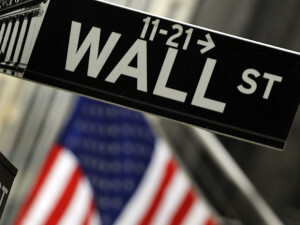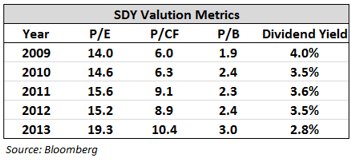Written by Ben Carlson

US dividend stocks have had a great run. They outperformed during the 2000-2002 bear market. They held their own in the ensuing bull market of 2003-2007. They have also made great investments since the 2008 downturn and subsequent recovery.
Since 2008, as measured by the SPDR S&P Dividend ETF (SDY), US dividend stocks are outperforming the S&P 500 by nearly 25% through the end of October.
This is quite a nice run for an investment that is generally considered to be stable and long-term in nature. Dividend stocks have also outperformed with much lower volatility than the rest of the market, which means that they have fluctuated in price much less than the overall market. As you can imagine, investors are much more comfortable investing in stocks that don’t exhibit wilds swings in price.
Studies have been coming out for the past few years showing the superiority of low volatility investment strategies, and investors have taken notice. Most of these low volatility stocks tend to be steady dividend paying companies, so they have been the beneficiary of continued investment by those looking to get in on this theme.
Investment 101 teaches that to earn a higher return on an asset you must take higher risk. Having low volatility stocks outperform high volatility stocks is therefore an anomaly that has caught the attention of the investing public.
Unfortunately, any time investors learn about an anomaly such as this they tend to pile into that investment theme and things can become overheated. You can also get investors involved that aren’t in it for the long haul.
I think that’s what has happened to US dividend paying stocks lately. Here’s a table with various valuation metrics to show how things have changed in the past five years:

You can see that price to earnings, price to cash flow, and price to book valuations have all been rising steadily. At the same time, the dividend yield has come down quite a bit from 2009. Obviously, any time a market has such a swift rise in price the valuation metrics are also going to rise.
But dividend stocks have historically tended to trade at or below market valuations. They have been steady cash flow generators with lower growth prospects than other segments of the market. This doesn’t seem to be the case right now.
The S&P 500 currently trades at a P/E multiple of 16.7 with a dividend yield of around 1.9%. So there’s still a higher yield in dividend stocks over the broader market. At the moment however, you’re paying a premium for that yield.
I’m not saying the US dividend stocks are setting up for a crash. I can’t predict the future. But it would be logical to conclude, that the higher performance against the broader market for US dividend paying stocks, could be lower going forward for a few years. Investing in US dividend paying stocks at higher valuations, and lower dividend yields, could lead to future disappointment for investors in these stocks.
Ben Carlson manages institutional investments and is the author of the blog A Wealth of Common Sense. Follow him on Twitter @awealthofcs.

Yeah, I hear you Ben. Gains seem to be very easy to come by in stocks. Good buys are not so plentiful. I’ve been a bit tepid toward putting new money into dividend stocks in the short term. As always, we shall see. Excellent and telling table.
-RBD
Thanks. It does seem hard to find good values with the performance we’ve seen. Things could definitely continue to rise for the foreseeable future but I think chasing the higher performance here could be a mistake.
Ben, great post!
Most of us would concur that the equity market is getting frothy, and starting to buy dividend stocks at these price levels carries inherent risk. Caution is definitely warranted.
I think for those of us who have already been invested in dividend stocks for a while now, the significant capital gains help to offset the decreasing yield. I’ve certainly noticed the overall lower yield of my portfolio. If monthly income was my only concern, i.e.retirement funding, then yes this would be a noticable impact.
My concern (as always) are those who are just starting to invest in any kind of equities, when we’ve seen such a significant run-up in markets (especially the U.S.). Even with a long-term view, buying high makes the longer-term outlook much longer. 😉
Cheers
Avrom
“the significant capital gains help to offset the decreasing yield.”
I agree but the significant capital gains you refer to are only realized once the stock is sold which automatically reduces your stock holdings and triggers a need for a decision as to where to put that capital gain money. This idea could give the impression that one should “re-balance” every time one suspects the market is getting “frothy”… beware of the demond market timing…the most insidious of evils!
This is why it’s probably a good idea to have an automatic rebalancing policy in your investment plan as well. That way you don’t have to guess whether the market is overvalued or not. You just do it once a year or so and sell some winners to buy some laggards. Not easy to do when you see large gains, but good for long-term discipline.
Glen,
Good points! The idea is to rebalance your fixed-income and equity positions regardless of market conditions. So you don’t need to suspect anything, the market will tell you when your equity position changes substantially.
However, since I’m generating dividend income from my stocks, and really not concerend with overall share value, selling isn’t even a consideration. The trade-off as Ben points out, is a lower yield.
Cheers
I’m avoiding buying at the moment and just saving up some capital for when the markets calm down a bit. Once the metrics more closely match those of 2009 I will be more likely to buy.
Any recommendations on what might be a good investment for someone who normally buys dividend stocks? What can I do while I wait for the prices to come down a bit?
This could probably be a follow up post. I think international markets offer better yields and values at the moment, but there aren’t many markets that don’t have substantial gains in the past 5 years.
It’s easy for investors to get sucked in after big gains but I think there are times when patience pays off. Now might be one of them.
I am waiting for the moment when the markets calm down for investment. Once the market more closely to 2009 I will be more likely to invest in stocks. If I decide to invest at current time then, I will go for international market just because for better dividend yields.
I’m not sure we should be comparing how much prices and valuations have risen since 2009 to determine if dividend stocks are overvalued. Back in 2009 we were still experiencing one of the worst recessions since the great depression. Once in a lifetime bargains were to be had if you were lucky enough to have money available for investing. What I’m seeing alot of lately is people thinking the market is priced way too high because they aren’t finding the bargains they were able to find in recent years due to the recession and now huge run up.
I’ll agree that dividend stocks are priced higher than the overall market right now and this does cause concern. However, I think an astute investor is still able to find some good dividend growth opportunities in todays market worth purchasing. Once I can’t find anything to purchase, that is when I will start complaining.
You’re right that it’s not fair to compare today with 2009 when investors were selling anything with liquidity and things got way overdone. That was a once in a generation buying opportunity that doesn’t come about very often.
But the changes in valuation trends from 2011/12 with this year worry me a bit as investors continue to seek out yield.
I get somewhat nervous when I see steady eddie stocks like CLX, JNJ, MRK and CL trading at PEs well above 20 at growth stock levels.
I think you’re right that investors might just need to be a bit more selective right now and not chase things higher.